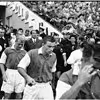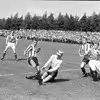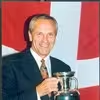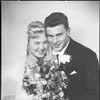"The one whom we should never have had”
- on football trainer Richard Møller Nielsen
Richard Møller Nielsen is, by far, the most successful football trainer the island of Funen has ever produced.
He was born in 1937 in Ejlstrup, near Odense, as the youngest child in a family with two much older children – or as his mother once said: “The one whom we should never have had”. His parents were not interested in sports, but already from childhood, Richard was gripped by football fever. After the 1948 Olympics, the Danish footballer Jørgen Leschly Sørensen became his great hero, and the 12-year-old Richard joined the football club OB (Odense Boldklub), which from then on became his second home.
As an active player, he was soon on OB’s Premier League team. The uncompromising defender managed to play in five Denmark Under-21 games, five Denmark B-team games and was capped twice for Denmark, and in 1958-59, he was even on a 3-month training camp at Arsenal.
On the field, Richard spared neither himself nor his opponents and that sealed his fate in a manner of speaking. In an international match against Norway in 1961, he tore a ligament but nevertheless continued playing until half-time. An operation was unsuccessful and later attempts to resume his career were in vain.
Richard was invalidated from football but never dropped it completely. In civilian life, he
worked admittedly first as a stock clerk and later as a storehouse manager for Svendborg Brewery and as a drayman. He allowed himself to be persuaded in 1963 to become a coach in the Sunday League club Brobyværk. Soon, a position as a coach became available in OB – the club advertised in a newspaper and Richard Møller Nielsen was one of the applicants for the job.
Richard’s appointment raised eyebrows. Was the young man who was as yet completely untried as a coach at divisional level up to the task? However, the ambitious young man quickly disproved his detractors. He licked the troops into shape and led the club back into the first division in 1966, but after four years working for OB, he went to Esbjerg where he was employed as a full-time coach.
Richard remained in Esbjerg for only two years, before returning to Funen as a coach for Svendborg. Before the 1975 season, Richard Møller Nielsen made a new contract with the blue- and white-striped OB Club, and with his usual glint in his eyes, stated in the club magazine that, the culprit was back at the scene of his crimes. At the OB Club in Ådal, Odense, he was responsible for a highly talented troop of footballers whom in 1977 he led to OB’s first Danish championship. And here, he emphasized the value of hard physical workouts. “A football player is useless if he cannot run around the island of Funen without taking a breath” was a part of his tactics. In general, his efforts led to the club’s increasing professionalism, resulting in the club winning yet another Danish championship in 1982 and the Danish Cup in 1983.
In 1985, OB and Richard parted ways. He had already been a coach for the Denmark Under 21 team, and soon also became an assistant coach for the Denmark team. When Sepp Piontek stopped, Richard took over as the new national coach after much controversy. He was criticized a great deal, but in 1992, he was vindicated when he coached Denmark to victory in the European Championships. A result never achieved before, and never surpassed since!
Richard Møller Nielsen died in 2014 aged 76. He was posthumously inducted into the Football Hall of Fame in Denmark.
You can find several photographs and other archive material on Richard Møller Nielsen and the Odense Football Club (OB) in the collections of the Odense City Archives.




